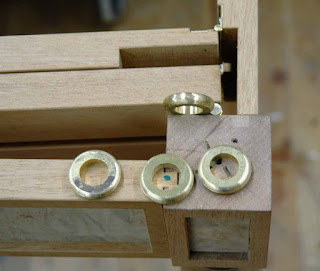
Well, the Wallace Family Show is officially open. The case and belt are on display and all the items available are listed on the Long Ago website at the link below. Beautiful stuff ... Check it out if you have a minute ...
Close up of the completed case with the belt

On view at Long Ago & Far Away

Above, a section of Dawn's new belt
Every year, Betsy and Grant Turner of Long Ago & Far Away in Manchester, Vermont, host a show for their long time friends Denise and Samuel, Dawn and David Wallace. I always enjoy catching up with the Wallace family and seeing their invariably exciting new work. This year, I have the special treat of making a display cabinet for Dawn Wallace's new belt. This is a complex and wonderful piece designed so that some of it's individual parts can be removed and worn as pins or pendants seperately from the belt. We've been working on the case for a couple days now and I think we'll wrap it up this week. We tried to create a design that would enhance the belt's display but not compete with it. Since the belt has a sea theme, we took a shell design from a table I made several years ago, placed pairs of them in the corners of the door of the case and added a 1/16th inch line of abalone to complement the blue/green theme of the belt. We have still to complete the final sanding, finishing and polishing but we have worked out the particulars and are in the home stretch ....
This is the cabinet as of Friday, hanging on the wall with it's first coat of finish and the belt "Photoshopped" in to give us an idea of the completed concept..
The vertical pieces of the door frame, with paua abalone lines from Stewart MacDonald (guitar supply) in a 1/16th " saw kerf. The shell inlays by Trevor are a mix of redwood and big leaf maple burl.
The case on the wall Friday. We used the closed version of this photo to Photoshop the picture below the text above.














































